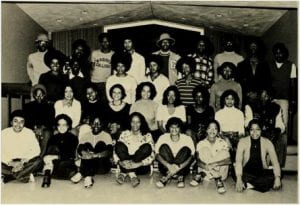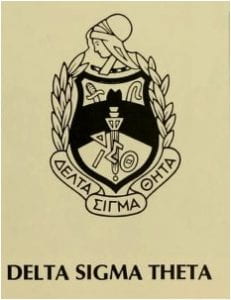Post Author: Alexandra Kolleda
While the first African-Americans were accepted during G. Tyler Miller’s presidency, it was Ronald E. Carrier, 4th president at Madison College, who truly raised the issue of diversity, and thus integration, to its current level of prominence at James Madison University. In order to have a diverse campus, Carrier could not simply limit the student body to white females, but had to expand his recruiting strategy to encourage those from other races, cultures, and socio-economic backgrounds.
Carrier believed that “focus centered on the students, with the first step being expansion of the size and diversity of the student body” (Jones, 168). Dr. Carrier also had his own experience with campus diversity in the south. He had attended East Tennessee State University as an undergrad, and through his participation in the Student Government Association, he invited black students to stay on campus for a conference. This was the first time that black students were allowed to stay in the dorms at East Tennessee, and Carrier had the responsibility of finding classmates to board these students (Carrier, 2).
Not only that, but Carrier was teaching economics at Ole Miss when the university was integrated. In 1962, James Meredith was enrolled at the University of Mississippi (Carrier, 4). Meredith was escorted by members of the national guard until his graduation; however, Carrier does not mention that animosity towards Meredith’s acceptance was so strong, that two of the federal marshals escorting him were killed (Hasday, 74-76). While Carrier presents these events as part of his history, it is important to acknowledge the help he received from the rest of the administration, including the Vice Presidents of Student Affairs and Academic Affairs (Hall, 2013). Carrier did not act as a one man force; however, he did take his experience with integration to his presidency at Madison College.

The BSA was supported by Dr. Carrier, showing his solidarity with integration.
Soon after Carrier’s inauguration, “enough African Americans had enrolled on campus to form a Black Student Alliance. Its stated purpose was to ‘articulate the problems of black students at Madison College; to promote interaction and involvement in school activities; to foster continuous Afro-American pride and responsibility; and to foster black awareness among ourselves and the student body'” (Jones, 168). The Black Student Alliance was open to students of all races in order to promote solidarity. These objectives, according to the alliance, were “necessary to provide a liberal education for all students at Madison” (Bluestone, 1975).

Carrier provided funding and formal support for several other efforts meant to promote diversity on campus. These included Delta Sigma Theta, which began at Madison College in 1971. Delta Sigma Theta is a service sorority that introduced a Black Emphasis week on campus. Members also worked with the local NAACP chapter and were actively involved in the recruitment of African American students to campus (Bluestone, 1973). Carrier’s administration initially struggled to recruit African Americans to Harrisonburg. In 1976, Daphyne Thomas, a Black woman, was hired into the Office of Admissions with the job of recruiting African Americans. Through her work, African American enrollment experienced a great spike (Thomas, 2013). In an interview, Carrier also credited the role of the new gospel choir, which the administration sent out across Virginia to sing at African American churches. Carrier said that because he had grown up in the south, he understood that Southern mothers would influence their children’s choice of college. He felt that the existence of an excellent gospel choir helped persuade African American mothers to send their children to Madison College (Carrier, 2013).
While Jay Rainey, a white student activist who promoted change on campus in the 1970s, claims that this liberalization was simply an inevitable product of the times, it seems that any other president might have been dragged kicking and screaming into the present (Rainey, 25). Carrier’s own personal philosophy was “to never let a problem fester,” forcing him to confront disagreements and allowing him to strip dissidents of their power (Carrier, 2013). G. Tyler Miller, 3rd president at Madison, had starkly contrasted with this philosophy, allowing conflicts to build up. Carrier, however, embraced the liberalization of the 1960s and 1970s, and with his experience in integration, he seemed to be the only person up for the job of diversifying Madison’s campus.
For more information on Carrier’s contributions to Madison College and his experience with integration see “The President” at http://sites.jmu.edu/mad70s/category/administration/the-president/
Continue to next post
Works Cited:
Bluestone. Harrisonburg: James Madison University, 1973-1975.
Carrier, Ronald E. Interview by Nancy B. Jones. April 22, 2002. transcript, Special Collections, Harrisonburg, VA.
Carrier, Ronald E. Class Speaker. Harrisonburg, VA. March 13, 2013.
Hall, William. Interview by author. Harrisonburg, VA. April 18, 2013.
Hasday, Judy L. The Civil Rights Act of 1964: An End to Racial Segregation. New York: Chelsea House Publishers, 2007.
Jones, Nancy Bondurant. Rooted on Blue Stone Hill: A History of James Madison University. Santa Fe: The Community Foundation of Harrisonburg and Rockingham County and the Center for American Places, 2004.
Rainey, Jay. Interview by Jeremy Turner. Blacksburg, VA. January 30, 1998. transcript, Special Collections, Harrisonburg, VA.
Thomas, Daphyne, Interview by author. Harrisonburg, VA. March 22, 2013.
